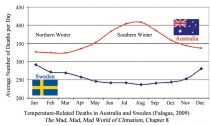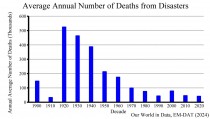Steve Goreham in the Washington Examiner,
The next big climate scare is on the way. Advocates of measures to control the climate now propose that we begin counting deaths from climate change. They appear to believe that if people see a daily announcement of climate deaths, they will be more inclined to accept climate change policies. But it’s not even clear that the current gentle rise in global temperatures is causing more people to die.
In December, former Secretary of State Hillary Clinton spoke at COP28, the 28th United Nations Climate Conference, and mentioned climate-related deaths.
“We are seeing and beginning to pay attention and to count and record the deaths that are related to climate,” she said. “And by far the biggest killer is extreme heat.”
---------
See the CO2 coalition video using the actual facts to clearly show the fallacy of this alarmist media and psuedoscientist claims that Steve discusses here:
------------
According to Ms. Clinton, Europe recorded 61,000 deaths from extreme heat in 2023, and she estimated that about 500,000 people died from heat across the world last year.
Global temperatures have been gently rising for the last 300 years. Temperature metrics from NASA, NOAA, and the Climate Research Unit at the University of East Anglia in the United Kingdom estimate that Earth’s surface temperatures have risen a little more than one degree Celsius, or about two degrees Fahrenheit, over the last 140 years. But are these warmer temperatures harmful to people?
According to the Centers for Disease Control and Prevention, most cases of influenza occur during December to March, the cold months in the United States. Influenza season in the southern hemisphere takes place during the cold months there, April through September. The peak months for COVID-19 infections tended to be the cold periods of the year. More people usually get sick during cold months than in warm months.
More people also die during winter months than summer months, according to many peer-reviewed studies. For example, Dr. Matthew Falagas of the Alfa Institute of Medical Sciences and five other researchers studied seasonal mortality in 11 nations. The research showed that the average number of deaths peaked in the coldest months of the year in all of them.

Enlarged: A graph showing the number of countries/regions in the winter
The late Dr. William Keating studied temperature-related deaths in six European countries for people aged 65 to 74. He concluded that deaths related to cold temperatures were nine times greater than those related to hot temperatures. Dr. Bjorn Lomborg, president of the Copenhagen Consensus Center, has pointed out that moderate global warming will likely reduce human mortality.
Yet, on January 30, Dr. Colin J. Carlson of Georgetown University published a paper in Nature Medicine titled, “After millions of preventable deaths, climate change must be treated like a health emergency.” Carlson claims that climate change has caused about 166,000 deaths per year since the year 2000, or almost four million cumulative deaths.
Carlson admits that most of these deaths have been due to malaria in sub-Saharan Africa, or malnutrition and diarrheal diseases in south Asia. But he goes on to claim that deaths due to natural disasters and even cardiovascular disease should also be attributed to climate change. If death from cardiovascular disease can be counted as a climate death, almost any death can be counted.
The evidence doesn’t support these climate death claims. Malarial disease has plagued humanity throughout history, even when temperatures were colder than today. Dr. Paul Reiter, medical entomologist at the Pasteur Institute in Paris, points out that malaria was endemic to England 400 years ago during the colder climate of the Little Ice Age. The Soviet Union experienced an estimated 13 million cases of malaria during the 1920s, with 30,000 cases occurring in Archangel, a city located close to the frozen Arctic Circle.
Malnutrition has been declining during the gentle warming of the last century. During the early 1900s, as many as 10 million people would die from famine each decade globally. Today, world famine deaths have been reduced to under 500,000 people per decade. About 10% of the world’s people are malnourished today, but this is down from about 25% in 1970.
The number of deaths from natural disasters has also been falling during the warming over the last century. According to EM-DAT, the International Disaster Database, the deaths from disasters, including storms, famines, earthquakes, droughts, and floods, are down more than 90 percent over the last 100 years.
With deaths from natural disasters and famine declining, and since fewer people die in warmer temperatures, the case for counting deaths from global warming is poor at best. But don’t underestimate the ability of climate alarmists to create fear by exaggerating the data.
Steve Goreham is a speaker on energy, the environment, and public policy and the author of the new bestselling book Green Breakdown: The Coming Renewable Energy Failure.
------------------
Icecap Note: Any warming not related to ocean, solar cycles or volcanism is driven by urbanization. NCEI has a data set(s) that are protected from the urban warming contamination by better instrumentation and especially better siting.






